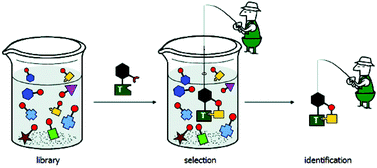Dynamic covalent capture of hydrazides by a phosphonate-target immobilized on resin
Abstract
A protocol is described that permits the self-selection of hydrazides from a small library by a phosphonate-target immobilized on resin. Hydrazides are captured by a neighbouring aldehyde group through reversible hydrazone bond formation. Stabilizing intramolecular interactions between the phosphonate-target and functional groups of the hydrazides drive the selection process. The phosphonate-target is introduced onto commercially available Tentagel resin through straightforward synthetic steps. The functionalized resin could be conveniently characterized by HR-MAS NMR spectroscopy using a recently developed transverse relaxation filter that eliminates the strong phase defects commonly observed with CPMG sequences. In addition, a protocol was developed to quantitatively remove the captured hydrazides from resin in order to analyse their composition by LC/MS. Kinetic experiments were used to study hydrazone formation and exchange on resin yielding similar results to those obtained previously in solution. Competition experiments showed that the system reaches thermodynamic equilibrium if multiple hydrazides are added to the resin. Finally, competition experiments showed that the immobilized phosphonate-target indeed amplifies the capture of those hydrazides able to develop stabilizing interactions with the target. Importantly, the obtained amplification profile was nearly identical to the ones obtained previously in solution studies. Notably, the observed amplification factors for the self-selected hydrazides were higher, which was attributed to steric effects imposed by the resin.


 Please wait while we load your content...
Please wait while we load your content...